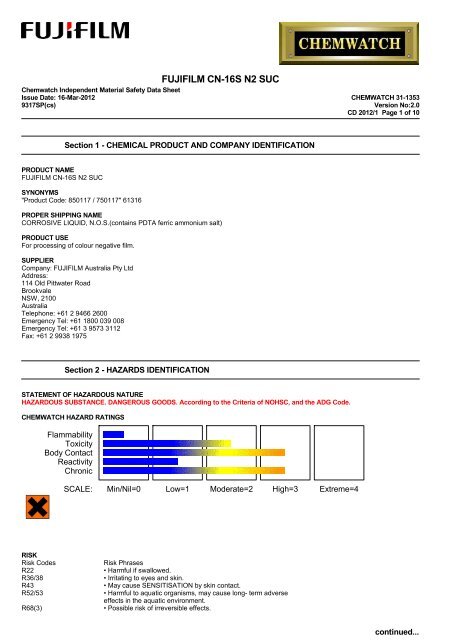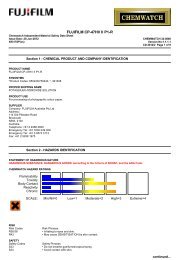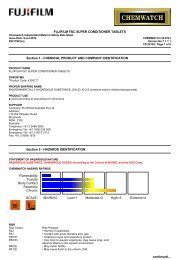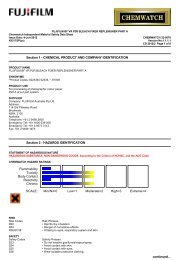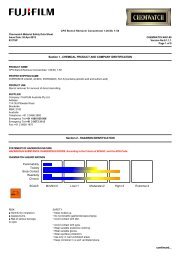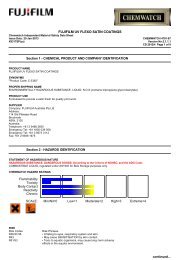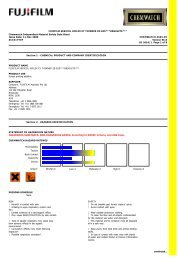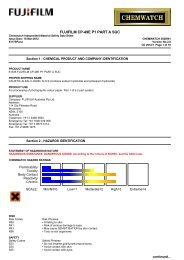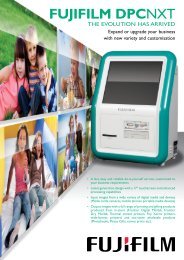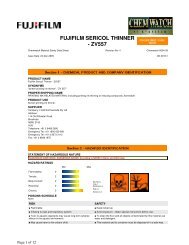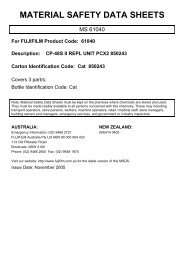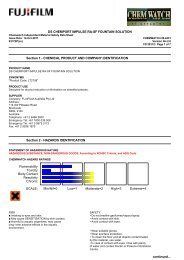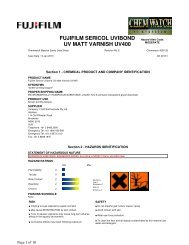Chemwatch Australian MSDS 31-1353 - FUJIFILM Australia
Chemwatch Australian MSDS 31-1353 - FUJIFILM Australia
Chemwatch Australian MSDS 31-1353 - FUJIFILM Australia
Create successful ePaper yourself
Turn your PDF publications into a flip-book with our unique Google optimized e-Paper software.
<strong>FUJIFILM</strong> CN-16S N2 SUC<br />
<strong>Chemwatch</strong> Independent Material Safety Data Sheet<br />
Issue Date: 16-Mar-2012 CHEMWATCH <strong>31</strong>-<strong>1353</strong><br />
9<strong>31</strong>7SP(cs)<br />
Version No:2.0<br />
CD 2012/1 Page 1 of 10<br />
Section 1 - CHEMICAL PRODUCT AND COMPANY IDENTIFICATION<br />
PRODUCT NAME<br />
<strong>FUJIFILM</strong> CN-16S N2 SUC<br />
SYNONYMS<br />
"Product Code: 850117 / 750117" 61<strong>31</strong>6<br />
PROPER SHIPPING NAME<br />
CORROSIVE LIQUID, N.O.S.(contains PDTA ferric ammonium salt)<br />
PRODUCT USE<br />
For processing of colour negative film.<br />
SUPPLIER<br />
Company: <strong>FUJIFILM</strong> <strong>Australia</strong> Pty Ltd<br />
Address:<br />
114 Old Pittwater Road<br />
Brookvale<br />
NSW, 2100<br />
<strong>Australia</strong><br />
Telephone: +61 2 9466 2600<br />
Emergency Tel: +61 1800 039 008<br />
Emergency Tel: +61 3 9573 <strong>31</strong>12<br />
Fax: +61 2 9938 1975<br />
Section 2 - HAZARDS IDENTIFICATION<br />
STATEMENT OF HAZARDOUS NATURE<br />
HAZARDOUS SUBSTANCE. DANGEROUS GOODS. According to the Criteria of NOHSC, and the ADG Code.<br />
CHEMWATCH HAZARD RATINGS<br />
Flammability<br />
Toxicity<br />
Body Contact<br />
Reactivity<br />
Chronic<br />
SCALE: Min/Nil=0 Low=1 Moderate=2 High=3 Extreme=4<br />
RISK<br />
Risk Codes<br />
Risk Phrases<br />
R22<br />
• Harmful if swallowed.<br />
R36/38 • Irritating to eyes and skin.<br />
R43<br />
• May cause SENSITISATION by skin contact.<br />
R52/53 • Harmful to aquatic organisms, may cause long- term adverse<br />
effects in the aquatic environment.<br />
R68(3)<br />
• Possible risk of irreversible effects.<br />
continued...
<strong>FUJIFILM</strong> CN-16S N2 SUC<br />
<strong>Chemwatch</strong> Independent Material Safety Data Sheet<br />
Issue Date: 16-Mar-2012 CHEMWATCH <strong>31</strong>-<strong>1353</strong><br />
9<strong>31</strong>7SP(cs)<br />
Version No:2.0<br />
CD 2012/1 Page 2 of 10<br />
Section 2 - HAZARDS IDENTIFICATION<br />
SAFETY<br />
Safety Codes<br />
S23<br />
S24<br />
S25<br />
S36<br />
S37<br />
S39<br />
S53<br />
S40<br />
S13<br />
S26<br />
S46<br />
S60<br />
Safety Phrases<br />
• Do not breathe gas/fumes/vapour/spray.<br />
• Avoid contact with skin.<br />
• Avoid contact with eyes.<br />
• Wear suitable protective clothing.<br />
• Wear suitable gloves.<br />
• Wear eye/face protection.<br />
• Avoid exposure - obtain special instructions before use.<br />
• To clean the floor and all objects contaminated by this material, use water.<br />
• Keep away from food, drink and animal feeding stuffs.<br />
• In case of contact with eyes, rinse with plenty of water and contact Doctor or<br />
Poisons Information Centre.<br />
• If swallowed, IMMEDIATELY contact Doctor or Poisons Information Centre. (show<br />
this container or label).<br />
• This material and its container must be disposed of as hazardous waste.<br />
Section 3 - COMPOSITION / INFORMATION ON INGREDIENTS<br />
NAME CAS RN %<br />
PDTA ferric ammonium salt 111687-36-6 10-20<br />
ammonium bromide 12124-97-9 5-10<br />
succinic acid 110-15-6 3-7<br />
maleic acid 110-16-7 3-7<br />
ammonium nitrate 6484-52-2 1-5<br />
imidazole 288-32-4 1-5<br />
water 7732-18-5 50-70<br />
Section 4 - FIRST AID MEASURES<br />
SWALLOWED<br />
• IF SWALLOWED, REFER FOR MEDICAL ATTENTION, WHERE POSSIBLE, WITHOUT DELAY.<br />
• For advice, contact a Poisons Information Centre or a doctor.<br />
• Urgent hospital treatment is likely to be needed.<br />
• In the mean time, qualified first-aid personnel should treat the patient following observation and employing supportive<br />
measures as indicated by the patient's condition.<br />
EYE<br />
■ If this product comes in contact with the eyes:<br />
• Wash out immediately with fresh running water.<br />
• Ensure complete irrigation of the eye by keeping eyelids apart and away from eye and moving the eyelids by occasionally lifting<br />
the upper and lower lids.<br />
• Seek medical attention without delay; if pain persists or recurs seek medical attention.<br />
• Removal of contact lenses after an eye injury should only be undertaken by skilled personnel.<br />
SKIN<br />
■ If skin contact occurs:<br />
• Immediately remove all contaminated clothing, including footwear.<br />
• Flush skin and hair with running water (and soap if available).<br />
• Seek medical attention in event of irritation.<br />
INHALED<br />
• If fumes, aerosols or combustion products are inhaled remove from contaminated area.<br />
• Other measures are usually unnecessary.<br />
• Inhalation of vapours or aerosols (mists, fumes) may cause lung oedema.<br />
• Corrosive substances may cause lung damage (e.g. lung oedema, fluid in the lungs).<br />
• As this reaction may be delayed up to 24 hours after exposure, affected individuals need complete rest (preferably in semirecumbent<br />
posture) and must be kept under medical observation even if no symptoms are (yet) manifested.<br />
• Before any such manifestation, the administration of a spray containing a dexamethasone derivative or beclomethasone derivative<br />
may be considered.<br />
NOTES TO PHYSICIAN<br />
■ Treat symptomatically.<br />
For acute or short term repeated exposures to iron and its derivatives:<br />
• Always treat symptoms rather than history.<br />
• In general, however, toxic doses exceed 20 mg/kg of ingested material (as elemental iron) with lethal doses exceeding 180 mg/kg.<br />
continued...
<strong>FUJIFILM</strong> CN-16S N2 SUC<br />
<strong>Chemwatch</strong> Independent Material Safety Data Sheet<br />
Issue Date: 16-Mar-2012 CHEMWATCH <strong>31</strong>-<strong>1353</strong><br />
9<strong>31</strong>7SP(cs)<br />
Version No:2.0<br />
CD 2012/1 Page 3 of 10<br />
Section 4 - FIRST AID MEASURES<br />
• Control of iron stores depend on variation in absorption rather than excretion. Absorption occurs through aspiration, ingestion<br />
and burned skin.<br />
• Hepatic damage may progress to failure with hypoprothrombinaemia and hypoglycaemia. Hepatorenal syndrome may occur.<br />
For acute or short term repeated exposures to strong acids:<br />
• Airway problems may arise from laryngeal edema and inhalation exposure. Treat with 100% oxygen initially.<br />
• Respiratory distress may require cricothyroidotomy if endotracheal intubation is contraindicated by excessive swelling<br />
• Intravenous lines should be established immediately in all cases where there is evidence of circulatory compromise.<br />
• Strong acids produce a coagulation necrosis characterised by formation of a coagulum (eschar) as a result of the dessicating<br />
action of the acid on proteins in specific tissues.<br />
For acute or short-term repeated exposures to highly alkaline materials:<br />
• Respiratory stress is uncommon but present occasionally because of soft tissue edema.<br />
• Unless endotracheal intubation can be accomplished under direct vision, cricothyroidotomy or tracheotomy may be necessary.<br />
• Oxygen is given as indicated.<br />
• The presence of shock suggests perforation and mandates an intravenous line and fluid administration.<br />
Treatment of intoxication by the bromide ion includes hydration, the maintenance of mild water diuresis, and sodium, or even<br />
better, ammonium chloride (10-15 gm. daily in divided doses) with an osmotic or high ceiling diuretic.<br />
In acute poisoning the stomach should be emptied by aspiration and lavage and sodium chloride given by intravenous infusion.<br />
Section 5 - FIRE FIGHTING MEASURES<br />
EXTINGUISHING MEDIA<br />
■ The product contains a substantial proportion of water, therefore there are no restrictions on the type of extinguishing media<br />
which may be used. Choice of extinguishing media should take into account surrounding areas.<br />
Though the material is non-combustible, evaporation of water from the mixture, caused by the heat of nearby fire, may produce<br />
floating layers of combustible substances.<br />
In such an event consider:<br />
• foam.<br />
FIRE FIGHTING<br />
• Alert Fire Brigade and tell them location and nature of hazard.<br />
• Wear full body protective clothing with breathing apparatus.<br />
• Prevent, by any means available, spillage from entering drains or water course.<br />
• Use fire fighting procedures suitable for surrounding area.<br />
FIRE/EXPLOSION HAZARD<br />
• Non combustible.<br />
• Not considered a significant fire risk, however containers may burn.<br />
Decomposition may produce toxic fumes of: carbon dioxide (CO2), nitrogen oxides (NOx), other pyrolysis products typical of<br />
burning organic material.<br />
FIRE INCOMPATIBILITY<br />
■ None known.<br />
HAZCHEM<br />
2X<br />
Section 6 - ACCIDENTAL RELEASE MEASURES<br />
MINOR SPILLS<br />
• Drains for storage or use areas should have retention basins for pH adjustments and dilution of spills before discharge or<br />
disposal of material.<br />
• Check regularly for spills and leaks.<br />
• Clean up all spills immediately.<br />
• Avoid breathing vapours and contact with skin and eyes.<br />
• Control personal contact by using protective equipment.<br />
• Contain and absorb spill with sand, earth, inert material or vermiculite.<br />
MAJOR SPILLS<br />
• Clear area of personnel and move upwind.<br />
• Alert Fire Brigade and tell them location and nature of hazard.<br />
• Wear full body protective clothing with breathing apparatus.<br />
• Prevent, by any means available, spillage from entering drains or water course.<br />
Personal Protective Equipment advice is contained in Section 8 of the <strong>MSDS</strong>.<br />
continued...
<strong>FUJIFILM</strong> CN-16S N2 SUC<br />
<strong>Chemwatch</strong> Independent Material Safety Data Sheet<br />
Issue Date: 16-Mar-2012 CHEMWATCH <strong>31</strong>-<strong>1353</strong><br />
9<strong>31</strong>7SP(cs)<br />
Version No:2.0<br />
CD 2012/1 Page 4 of 10<br />
Section 7 - HANDLING AND STORAGE<br />
PROCEDURE FOR HANDLING<br />
• DO NOT allow clothing wet with material to stay in contact with skin.<br />
• Avoid all personal contact, including inhalation.<br />
• Wear protective clothing when risk of exposure occurs.<br />
• Use in a well-ventilated area.<br />
• Avoid contact with moisture.<br />
SUITABLE CONTAINER<br />
• DO NOT use aluminium or galvanised containers.<br />
• Check regularly for spills and leaks.<br />
• Lined metal can, lined metal pail/ can.<br />
• Plastic pail.<br />
• Polyliner drum.<br />
• Packing as recommended by manufacturer.<br />
For low viscosity materials<br />
• Drums and jerricans must be of the non-removable head type.<br />
• Where a can is to be used as an inner package, the can must have a screwed enclosure.
<strong>FUJIFILM</strong> CN-16S N2 SUC<br />
<strong>Chemwatch</strong> Independent Material Safety Data Sheet<br />
Issue Date: 16-Mar-2012 CHEMWATCH <strong>31</strong>-<strong>1353</strong><br />
9<strong>31</strong>7SP(cs)<br />
Version No:2.0<br />
CD 2012/1 Page 5 of 10<br />
Section 8 - EXPOSURE CONTROLS / PERSONAL PROTECTION<br />
MALEIC ACID:<br />
SUCCINIC ACID:<br />
■ Sensory irritants are chemicals that produce temporary and undesirable side-effects on the eyes, nose or throat.<br />
Historically occupational exposure standards for these irritants have been based on observation of workers' responses to various<br />
airborne concentrations.<br />
<strong>FUJIFILM</strong> CN-16S N2 SUC:<br />
PDTA FERRIC AMMONIUM SALT:<br />
■ The recommended TLV is thought to reduce the likelihood of respiratory irritation and skin irritation from exposure to<br />
aerosols and mists of soluble iron salts.<br />
WATER:<br />
■ No exposure limits set by NOHSC or ACGIH.<br />
PERSONAL PROTECTION<br />
RESPIRATOR<br />
•Type AK-P Filter of sufficient capacity. (AS/NZS 1716 & 1715, EN 143:2000 & 149:2001, ANSI Z88 or national equivalent)<br />
EYE<br />
• Safety glasses with side shields.<br />
• Chemical goggles.<br />
• Contact lenses may pose a special hazard; soft contact lenses may absorb and concentrate irritants. A written policy document,<br />
describing the wearing of lens or restrictions on use, should be created for each workplace or task. This should include a<br />
review of lens absorption and adsorption for the class of chemicals in use and an account of injury experience. Medical and<br />
first-aid personnel should be trained in their removal and suitable equipment should be readily available. In the event of<br />
chemical exposure, begin eye irrigation immediately and remove contact lens as soon as practicable. Lens should be removed at<br />
the first signs of eye redness or irritation - lens should be removed in a clean environment only after workers have washed<br />
hands thoroughly. [CDC NIOSH Current Intelligence Bulletin 59], [AS/NZS 1336 or national equivalent].<br />
HANDS/FEET<br />
• Wear chemical protective gloves, eg. PVC.<br />
• Wear safety footwear or safety gumboots, eg. Rubber.<br />
NOTE:<br />
• The material may produce skin sensitisation in predisposed individuals. Care must be taken, when removing gloves and other<br />
protective equipment, to avoid all possible skin contact.<br />
• Contaminated leather items, such as shoes, belts and watch-bands should be removed and destroyed.<br />
Suitability and durability of glove type is dependent on usage. Important factors in the selection of gloves include:<br />
• frequency and duration of contact,<br />
• chemical resistance of glove material,<br />
• glove thickness and<br />
• dexterity.<br />
OTHER<br />
• Overalls.<br />
• PVC Apron.<br />
• PVC protective suit may be required if exposure severe.<br />
• Eyewash unit.<br />
ENGINEERING CONTROLS<br />
■ Engineering controls are used to remove a hazard or place a barrier between the worker and the hazard. Well-designed<br />
engineering controls can be highly effective in protecting workers and will typically be independent of worker interactions to<br />
provide this high level of protection.<br />
The basic types of engineering controls are:<br />
Process controls which involve changing the way a job activity or process is done to reduce the risk.<br />
Enclosure and/or isolation of emission source which keeps a selected hazard "physically" away from the worker and ventilation<br />
that strategically "adds" and "removes" air in the work environment.<br />
continued...
<strong>FUJIFILM</strong> CN-16S N2 SUC<br />
<strong>Chemwatch</strong> Independent Material Safety Data Sheet<br />
Issue Date: 16-Mar-2012 CHEMWATCH <strong>31</strong>-<strong>1353</strong><br />
9<strong>31</strong>7SP(cs)<br />
Version No:2.0<br />
CD 2012/1 Page 6 of 10<br />
Section 9 - PHYSICAL AND CHEMICAL PROPERTIES<br />
APPEARANCE<br />
Clear dark green acidic liquid with no odour; mixes with water.<br />
PHYSICAL PROPERTIES<br />
Liquid.<br />
Mixes with water.<br />
Corrosive.<br />
Acid.<br />
State Liquid Molecular Weight Not Applicable<br />
Melting Range (°C) Not Available Viscosity Not Available<br />
Boiling Range (°C) >100 Solubility in water (g/L) Miscible<br />
Flash Point (°C) Not Applicable pH (1% solution) Not Availab le<br />
Decomposition Temp (°C) Not Available pH (as supplied) 3.8<br />
Autoignition Temp (°C) Not Applicable Vapour Pressure (kPa ) ~2.0 @ 25C<br />
Upper Explosive Limit (%) Not Applicable Specific Gravity (water=1) 1.17<br />
Lower Explosive Limit (%) Not Applicable Relative Vapour Density Not Available<br />
(air=1)<br />
Volatile Component (%vol) Not Available Evaporation Rate Not Available<br />
imidazole<br />
log Kow (Sangster 1997): - 0.08<br />
Section 10 - STABILITY AND REACTIVITY<br />
CONDITIONS CONTRIBUTING TO INSTABILITY<br />
• Contact with alkaline material liberates heat.<br />
For incompatible materials - refer to Section 7 - Handling and Storage.<br />
Section 11 - TOXICOLOGICAL INFORMATION<br />
POTENTIAL HEALTH EFFECTS<br />
ACUTE HEALTH EFFECTS<br />
SWALLOWED<br />
■ Accidental ingestion of the material may be harmful; animal experiments indicate that ingestion of less than 150 gram may be<br />
fatal or may produce serious damage to the health of the individual.<br />
EYE<br />
■ This material can cause eye irritation and damage in some persons.<br />
SKIN<br />
■ This material can cause inflammation of the skin oncontact in some persons.<br />
The material may accentuate any pre-existing dermatitis condition.<br />
Entry into the blood-stream, through, for example, cuts, abrasions or lesions, may produce systemic injury with harmful effects.<br />
Examine the skin prior to the use of the material and ensure that any external damage is suitably protected.<br />
INHALED<br />
■ There is some evidence to suggest that the material can cause respiratory irritation in some persons. The body's response to<br />
such irritation can cause further lung damage.<br />
Not normally a hazard due to non-volatile nature of product.<br />
CHRONIC HEALTH EFFECTS<br />
■ Strong evidence exists that this substance may cause irreversible mutations (though not lethal) even following a single<br />
exposure.<br />
Skin contact with the material is more likely to cause a sensitisation reaction in some persons compared to the general<br />
population.<br />
Substance accumulation, in the human body, may occur and may cause some concern following repeated or long-term occupational<br />
exposure.<br />
There is some evidence from animal testing that exposure to this material may result in toxic effects to the unborn baby.<br />
Based on experience with similar materials, there is a possibility that exposure to the material may reduce fertility in humans<br />
at levels which do not cause other toxic effects.<br />
continued...
<strong>FUJIFILM</strong> CN-16S N2 SUC<br />
<strong>Chemwatch</strong> Independent Material Safety Data Sheet<br />
Issue Date: 16-Mar-2012 CHEMWATCH <strong>31</strong>-<strong>1353</strong><br />
9<strong>31</strong>7SP(cs)<br />
Version No:2.0<br />
CD 2012/1 Page 7 of 10<br />
Section 11 - TOXICOLOGICAL INFORMATION<br />
Chronic intoxication with ionic bromides, historically, has resulted from medical use of bromides but not from environmental or<br />
occupational exposure; depression, hallucinosis, and schizophreniform psychosis can be seen in the absence of other signs of<br />
intoxication. Bromides may also induce sedation, irritability, agitation, delirium, memory loss, confusion, disorientation,<br />
forgetfulness (aphasias), dysarthria, weakness, fatigue, vertigo, stupor, coma, decreased appetite, nausea and vomiting,<br />
diarrhoea, hallucinations, an acne like rash on the face, legs and trunk, known as bronchoderma (seen in 25-30% of case involving<br />
bromide ion), and a profuse discharge from the nostrils (coryza).<br />
Chelates are occasionally used in therapies for various forms of poisoning. A systemic reaction known as the "excessive chelation<br />
syndrome" consists mainly of general unwellness, fatigue, thirst, followed by chills and fever. Muscle ache, headache, loss of<br />
appetite, nausea and occasionally increased urinary urgency and frequency may occur, as may cold-like symptoms.<br />
Wide area external application of antihistamines can cause various side effects, including sensitisation and eczema.<br />
TOXICITY AND IRRITATION<br />
■ Contact allergies quickly manifest themselves as contact eczema, more rarely as urticaria or Quincke's oedema. The pathogenesis<br />
of contact eczema involves a cell-mediated (T lymphocytes) immune reaction of the delayed type. Other allergic skin reactions,<br />
e.g. contact urticaria, involve antibody-mediated immune reactions. The significance of the contact allergen is not simply<br />
determined by its sensitisation potential: the distribution of the substance and the opportunities for contact with it are<br />
equally important. A weakly sensitising substance which is widely distributed can be a more important allergen than one with<br />
stronger sensitising potential with which few individuals come into contact. From a clinical point of view, substances are<br />
noteworthy if they produce an allergic test reaction in more than 1% of the persons tested.<br />
No significant acute toxicological data identified in literature search.<br />
for acid mists, aerosols, vapours<br />
Data from assays for genotoxic activity in vitro suggest that eukaryotic cells are susceptible to genetic damage when the pH<br />
falls to about 6.5. Cells from the respiratory tract have not been examined in this respect.<br />
Asthma-like symptoms may continue for months or even years after exposure to the material ceases. This may be due to a nonallergenic<br />
condition known as reactive airways dysfunction syndrome (RADS) which can occur following exposure to high levels of<br />
highly irritating compound.<br />
CARCINOGEN<br />
Nitrate or nitrite International Agency for Research on Cancer Group<br />
(ingested) under<br />
(IARC) - Agents Reviewed by the IARC<br />
conditions that<br />
Monographs<br />
result in endogenous<br />
nitrosation<br />
Non- arsenical International Agency for Research on Cancer Group 2A<br />
insecticides<br />
(IARC) - Agents Reviewed by the IARC<br />
(occupational<br />
Monographs<br />
exposures in spraying<br />
and application of)<br />
Section 12 - ECOLOGICAL INFORMATION<br />
Harmful to aquatic organisms, may cause long-term adverse effects in the aquatic environment.<br />
This material and its container must be disposed of as hazardous waste.<br />
Ecotoxicity<br />
Ingredient Persistence: Persistence: Air Bioaccumulation Mobility<br />
Water/Soil<br />
PDTA ferric ammonium salt No Data No Data<br />
Available<br />
Available<br />
ammonium bromide No Data No Data<br />
Available<br />
Available<br />
succinic acid LOW No Data LOW HIGH<br />
Available<br />
maleic acid LOW No Data LOW HIGH<br />
Available<br />
ammonium nitrate No Data No Data LOW<br />
Available<br />
Available<br />
imidazole LOW No Data LOW HIGH<br />
Available<br />
continued...
<strong>FUJIFILM</strong> CN-16S N2 SUC<br />
<strong>Chemwatch</strong> Independent Material Safety Data Sheet<br />
Issue Date: 16-Mar-2012 CHEMWATCH <strong>31</strong>-<strong>1353</strong><br />
9<strong>31</strong>7SP(cs)<br />
Version No:2.0<br />
CD 2012/1 Page 8 of 10<br />
Section 13 - DISPOSAL CONSIDERATIONS<br />
• Containers may still present a chemical hazard/ danger when empty.<br />
• Return to supplier for reuse/ recycling if possible.<br />
Otherwise:<br />
• If container can not be cleaned sufficiently well to ensure that residuals do not remain or if the container cannot be used to<br />
store the same product, then puncture containers, to prevent re-use, and bury at an authorised landfill.<br />
• Where possible retain label warnings and <strong>MSDS</strong> and observe all notices pertaining to the product.<br />
Legislation addressing waste disposal requirements may differ by country, state and/ or territory. Each user must refer to laws<br />
operating in their area.<br />
A Hierarchy of Controls seems to be common - the user should investigate:<br />
• Reduction.<br />
• DO NOT allow wash water from cleaning or process equipment to enter drains.<br />
• It may be necessary to collect all wash water for treatment before disposal.<br />
• In all cases disposal to sewer may be subject to local laws and regulations and these should be considered first.<br />
• Where in doubt contact the responsible authority.<br />
• Recycle wherever possible.<br />
• Consult manufacturer for recycling options or consult local or regional waste management authority for disposal if no suitable<br />
treatment or disposal facility can be identified.<br />
• Treat and neutralise at an approved treatment plant. Treatment should involve: Neutralisation with soda-ash or soda-lime<br />
followed by: burial in a land-fill specifically licenced to accept chemical and / or pharmaceutical wastes or Incineration in a<br />
licenced apparatus (after admixture with suitable combustible material).<br />
• Decontaminate empty containers with 5% aqueous sodium hydroxide or soda ash, followed by water. Observe all label safeguards<br />
until containers are cleaned and destroyed.<br />
Section 14 - TRANSPORTATION INFORMATION<br />
Labels Required: CORROSIVE<br />
HAZCHEM:<br />
2X (ADG7)<br />
ADG7:<br />
Class or Division: 8 Subsidiary Risk: None<br />
UN No.: 1760 Packing Group: III<br />
Special Provision: 223 274 Limited Quantity: 5 L<br />
Portable Tanks & Bulk T7 Portable Tanks & Bulk TP1 TP28<br />
Containers -<br />
Containers - Special<br />
Instruction:<br />
Provision:<br />
Packagings & IBCs - None Packagings & IBCs - P001 IBC03 LP01<br />
Packing Instruction:<br />
Special Packing<br />
Provision:<br />
Name and Description: CORROSIVE LIQUID, N.O.S. (contains PDTA ferric<br />
ammonium salt)<br />
Land Transport UNDG:<br />
Class or division: 8 Subsidiary risk: None<br />
UN No.: 1760 UN packing group: III<br />
Shipping Name:CORROSIVE LIQUID, N.O.S. (contains PDTA ferric ammonium<br />
salt)<br />
Air Transport IATA:<br />
ICAO/IATA Class: 8 ICAO/IATA Subrisk: None<br />
UN/ID Number: 1760 Packing Group: III<br />
Special provisions:<br />
A3<br />
Shipping name:CORROSIVE LIQUID, N.O.S.(contains PDTA ferric ammonium salt)<br />
Maritime Transport IMDG:<br />
IMDG Class: 8 IMDG Subrisk: None<br />
UN Number: 1760 Packing Group: III<br />
EMS Number: F- A, S- B Special provisions: 223 274<br />
Limited Quantities:<br />
5 L<br />
Shipping name:CORROSIVE LIQUID, N.O.S.(contains PDTA ferric ammonium salt)<br />
continued...
<strong>FUJIFILM</strong> CN-16S N2 SUC<br />
<strong>Chemwatch</strong> Independent Material Safety Data Sheet<br />
Issue Date: 16-Mar-2012 CHEMWATCH <strong>31</strong>-<strong>1353</strong><br />
9<strong>31</strong>7SP(cs)<br />
Version No:2.0<br />
CD 2012/1 Page 9 of 10<br />
Section 14 - TRANSPORTATION INFORMATION<br />
Section 15 - REGULATORY INFORMATION<br />
POISONS SCHEDULE None<br />
REGULATIONS<br />
Regulations for ingredients<br />
PDTA ferric ammonium salt (CAS: 111687-36-6) is found on the following regulatory lists;<br />
"<strong>Australia</strong> Hazardous Substances","<strong>Australia</strong> Inventory of Chemical Substances (AICS)","<strong>Australia</strong> National Pollutant Inventory"<br />
ammonium bromide (CAS: 12124-97-9) is found on the following regulatory lists;<br />
"<strong>Australia</strong> Inventory of Chemical Substances (AICS)","<strong>Australia</strong> National Pollutant Inventory","<strong>Australia</strong> Standard for the Uniform<br />
Scheduling of Medicines and Poisons (SUSMP) - Appendix E (Part 2)","<strong>Australia</strong> Standard for the Uniform Scheduling of Medicines<br />
and Poisons (SUSMP) - Schedule 4","<strong>Australia</strong> Standard for the Uniform Scheduling of Medicines and Poisons (SUSMP) - Schedule 5",<br />
"<strong>Australia</strong> Standard for the Uniform Scheduling of Medicines and Poisons (SUSMP) - Schedule 6","OECD List of High Production<br />
Volume (HPV) Chemicals","OSPAR National List of Candidates for Substitution – Norway","OSPAR National List of Candidates for<br />
Substitution – United Kingdom","WHO Guidelines for Drinking-water Quality - Chemicals for which guideline values have not been<br />
established"<br />
succinic acid (CAS: 110-15-6) is found on the following regulatory lists;<br />
"<strong>Australia</strong> Inventory of Chemical Substances (AICS)","<strong>Australia</strong> National Pollutant Inventory","International Fragrance Association<br />
(IFRA) Survey: Transparency List","OECD List of High Production Volume (HPV) Chemicals"<br />
maleic acid (CAS: 110-16-7) is found on the following regulatory lists;<br />
"<strong>Australia</strong> Hazardous Substances","<strong>Australia</strong> Inventory of Chemical Substances (AICS)","OECD List of High Production Volume (HPV)<br />
Chemicals","United Nations Consolidated List of Products Whose Consumption and/or Sale Have Been Banned, Withdrawn, Severely<br />
Restricted or Not Approved by Governments"<br />
ammonium nitrate (CAS: 6484-52-2) is found on the following regulatory lists;<br />
"<strong>Australia</strong> - <strong><strong>Australia</strong>n</strong> Capital Territory - Environment Protection Regulation: Ambient environmental standards (Domestic water<br />
supply - inorganic chemicals)","<strong>Australia</strong> - <strong><strong>Australia</strong>n</strong> Capital Territory - Environment Protection Regulation: Ambient<br />
environmental standards (STOCK - inorganic chemicals)","<strong>Australia</strong> - <strong><strong>Australia</strong>n</strong> Capital Territory - Environment Protection<br />
Regulation: Pollutants entering waterways taken to cause environmental harm (Domestic water supply quality)","<strong>Australia</strong> -<br />
<strong><strong>Australia</strong>n</strong> Capital Territory - Environment Protection Regulation: Pollutants entering waterways taken to cause environmental harm<br />
(STOCK)","<strong>Australia</strong> - Western <strong>Australia</strong> Hazardous Substances Prohibited for Specified Uses or Methods of Handling","<strong>Australia</strong><br />
Council of <strong><strong>Australia</strong>n</strong> Governments (COAG) Chemicals of Security Concern","<strong>Australia</strong> Dangerous Goods Code (ADG Code) - Goods Too<br />
Dangerous To Be Transported","<strong>Australia</strong> Inventory of Chemical Substances (AICS)","<strong>Australia</strong> National Pollutant Inventory",<br />
"<strong>Australia</strong> Standard for the Uniform Scheduling of Medicines and Poisons (SUSMP) - Appendix F (Part 3)","OECD List of High<br />
Production Volume (HPV) Chemicals"<br />
imidazole (CAS: 288-32-4) is found on the following regulatory lists;<br />
"<strong>Australia</strong> Inventory of Chemical Substances (AICS)","<strong>Australia</strong> National Pollutant Inventory","OECD List of High Production Volume<br />
(HPV) Chemicals"<br />
water (CAS: 7732-18-5) is found on the following regulatory lists;<br />
"<strong>Australia</strong> Inventory of Chemical Substances (AICS)","International Fragrance Association (IFRA) Survey: Transparency List","OECD<br />
List of High Production Volume (HPV) Chemicals","OSPAR National List of Candidates for Substitution – Norway"<br />
No data for Fujifilm CN-16S N2 SUC (CW: <strong>31</strong>-<strong>1353</strong>)<br />
Section 16 - OTHER INFORMATION<br />
Denmark Advisory list for selfclassification of dangerous substances<br />
Substance CAS Suggested codes<br />
imidazole 288- 32- 4 Xn; R22<br />
■ Classification of the preparation and its individual components has drawn on official and authoritative sources as well as<br />
independent review by the <strong>Chemwatch</strong> Classification committee using available literature references.<br />
A list of reference resources used to assist the committee may be found at:<br />
www.chemwatch.net/references.<br />
■ The (M)SDS is a Hazard Communication tool and should be used to assist in the Risk Assessment. Many factors determine whether<br />
the reported Hazards are Risks in the workplace or other settings.<br />
This document is copyright. Apart from any fair dealing for the purposes of private study, research, review or<br />
criticism, as permitted under the Copyright Act, no part may be reproduced by any process without written<br />
permission from CHEMWATCH. TEL (+61 3) 9572 4700.<br />
continued...
<strong>FUJIFILM</strong> CN-16S N2 SUC<br />
<strong>Chemwatch</strong> Independent Material Safety Data Sheet<br />
Issue Date: 16-Mar-2012 CHEMWATCH <strong>31</strong>-<strong>1353</strong><br />
9<strong>31</strong>7SP(cs)<br />
Version No:2.0<br />
CD 2012/1 Page 10 of 10<br />
Section 16 - OTHER INFORMATION<br />
Issue Date: 16-Mar-2012<br />
Print Date: 16-Mar-2012<br />
This is the end of the <strong>MSDS</strong>.


